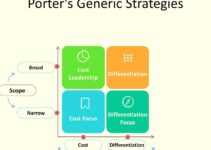Introduction
Many businesses and companies consider marketing as a way of advertising a company’s products/services on various platforms. It’s a bit oversimplified approach and it would consume a lot of your marketing budget. However, developing a strategic marketing plan is the key to achieve your marketing goals. Today, we’ll discuss what is a strategic marketing plan; and the strategic marketing planning process. l
What is a Strategic Marketing Plan?
The strategic marketing plan (SMP) is the process of developing a marketing strategy that discusses your marketing goals, how and when you’re planning to meet those goals, and who would create metrics. The SMP provides the founding of developing long-term marketing decisions.
Strategic Marketing vs. Marketing Plan
The top-level management provides direction to the business in the form of a strategic marketing plan. The SMP acts as a blueprint for the marketing plan and guides that how the company should implement its strategy. Under the surface of SMP, you’ll find a marketing plan providing tactics to achieve them.
Many SMEs abruptly launch marketing without developing strategic marketing and marketing plans first. It results in the form of consumption of a plethora of resources without getting anything in return.
Strategic Marketing Planning Process
After discussing what is a strategic marketing plan; it’s time to discuss the strategic marketing planning process. It comprises of series of steps, and those steps are as follows;
Mission
First of all, you should recognize and comprehend the mission statement of the company and you may find its cliché slogan across the organization. If you don’t find it, then you should talk to the company’s stakeholders and ask them about the reason for its existence. They would tell you why the company is running the business and how it’s benefiting the customers.
Mission statements are sometimes inspiring, aspiring, and motivating for the company’s stakeholders. Or they tell people what they are in simple words. However, you can’t develop a company’s marketing strategy without comprehending its mission statement and the reason of its doing the business.
Example:
The mission statement of IKEA is as follows;
“At IKEA, our vision is to create a better everyday life for many people. Our business idea supports this vision by offering a wide range of well-designed, functional home furnishing products at prices so low that as many people as possible will be able to afford them.”
In short, the mission statement delivers the key message that impacts your marketing strategy. Some of the questions that you should ask while analyzing the mission statement are as follows;
- Why the company is doing this line of business
- The purpose and goal of doing the business
- The strategic influence on your business
- The desired public image of your organization
- How the company’s mission statement is influencing the marketing strategy
- How the mission statement is uniting the marketing team
Situation Analysis
Situation analysis means that you should analyze internal and external factors that are impacting your business and market. The analysis would help you to focus on internal strengths, the challenges company is facing, internal resources, and external competitors. It offers a clear view of the health of your business so that you could comprehend the company’s market position, industry trends, and potential customers.
You can conduct the situation analysis in many ways. Swot analysis is a very famous analytical tool for studying strengths, weaknesses, opportunities, and threats. However, strengths and weaknesses are the controllable internal factors, while opportunities and threats are the uncontrollable external factors.
- Strengths: how well your business is doing, its competitive advantage, factors that you can control, and superiority of your products/services in the market.
- Weaknesses: what areas where your company is not performing well, resources impacting the success of your business, and what factors are stopping you to succeed.
- Opportunities: the untapped areas of the market that you haven’t exploited yet, taking advantage of the new market trends, and the growing potential for new businesses
- Threats: the obstacles business is facing in the market, political/economical/social/technological/legal factors are impacting the company.
5C analysis is another famous tool of analyzing the company and market like swot analysis. Some of the main elements of the 5C analysis are as follows;
- Company: your successful product/service line, the image of your company in the market, the effectiveness of your company in terms of achieving goals, and how the company’s culture is impacting your performance.
- Consumers: the market size of your target audience, growth of your customer market, the eagerness of customers to buy your product/service, sale trends, and changing buying pattern of customers.
- Competitors: future, indirect, and direct competitors of your business, product/service and market share of competitors, their strengths and weaknesses, and their market position.
- Collaborators: agencies, partners, distributors, and suppliers of your business, growth of your business, and stability of your business impacting the success.
- Climate: regulations and government policies impacting your business, inflation and interest rate impacting it, market trends, the impact of technology, and how you can use technology to gain a competitive edge.
Planning/Marketing Strategy
The company/market analysis helps you to recognize the potential opportunities available in the market. Now, you should map out the plan that how you should pursue those opportunities. It means that you have to write a marketing plan focusing on the target customers that how you would approach them and forecast the expected results. Keep in mind the following questions;
- How you would reply to competitors
- The cost of your marketing plan
- The reply of customers towards your marketing plans
The situation analysis and the marketing research would give you sufficient data to establish a plan.
Defining Target Audience
Only some companies recognize the needs and want of the customer market. You should divide the market into different segments relevant to your strengths and opportunities. It’s to recognize customers and you can choose the target market based on demographic, behavior, and other characteristics. It’s significant to remember that you should define the target customer market and it has the capability to support your product/service.
However, it’s probable that you would have some information about your target customer market from the situation. It is better that you should conduct thorough market research to recognize the needs and wants of customers. It would allow you to develop a profile of your target customers. The more you know your customers, the better you can develop a product/service for them.
Goal Setting
If you want to develop successful goals, then you should create measurable and specific goals. If you want to increase the sale of your business, then you should set the goals that would deliver you the results on time. In short, your goals should be realistic, attainable, and achievable that you can measure their performance. Make sure to create the SMART (specific, measurable, achievable, relevant, time-oriented) goals.
Marketing Budget
After developing the plan, it’s time to implement your plans. While doing so, your marketing budget should include various costs like staffing costs, public relations, branding, online content, advertising, and much more. When it comes to it, then you have to make some tough decisions in terms of prioritizing it into various areas. Or you can create an affordable marketing budget, make sure that it should be relevant to your budget.
Marketing Mix
The marketing mix comprises four elements; product, price, place, and promotion. It means that you have to conduct the market research of developing the product relevant to your target customer market and choosing the right channels to deliver the message to the customers.
- Product: it means devising the features of your product, it is packaging, warranties, service/support, quality, and branding.
- Price: it includes terms and conditions, how flexible you’re, payment period, commission, perceived value, discount, and the list price.
- Place: it comprises storage facility, transportation, outlet location, and distribution channels.
- Promotion: it means publicity of your brand and product/service, sales, public relations, and advertising channel.
Implementation & Control
After developing the marketing strategy and allocating the budget, it is time to implement your plan into action. Here you approach customers and convince them to buy your product. Next, you keep on marketing the product, organizing resources and people to keep things on track, and managing goals. If you keep on evaluating the goals on a daily/weekly/monthly basis, then it would help you to be focused.
You should keep in mind that the strategic marketing planning process is dynamic and you have to evaluate the performance of your goals regularly. It helps you to see whether you’re achieving your goals or not in terms of website visitors, customer satisfaction, sales, revenue, and other metrics so that you could make adjustments accordingly.
Example of Strategic Marketing Planning Process
Here’s an example of the strategic marketing plan, and its various steps in the strategic marketing planning process are as follows;
- Mission: Apple has a mission of developing high-quality innovative products
- Situation Analysis: Apple gains a competitive edge with its commitment to comprehend the needs and wants of customers, promoting the culture of collaboration, and developing products that are relevant to its mission.
- Marketing Strategy: Apple has established the reputation of being the market leader by firstly launching new products in the market, and the brand depends on its loyal customers to try out its new offer.
- Marketing Mix: Apple provides a vast range of products for customers to choose from and the company follows a strict protocol for the distribution of its products
- Implementation & Control: Apple offers the products/services in the same product line and they all complement each other. The company creates brand loyalty and the customers expect the same from the company.
Conclusion: What is a Strategic Marketing Plan?
After an in-depth study of what is a strategic marketing plan and the strategic marketing planning process, we’ve concluded that strategic marketing helps businesses to develop and achieve effective long terms goals. If you want to learn about the SMP, then follow and practice the abovementioned process.

Ahsan Ali Shaw is an accomplished Business Writer, Analyst, and Public Speaker. Other than that, he’s a fun loving person.


